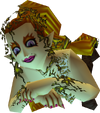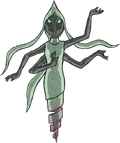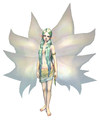 Fairies are tiny, humanoid, supernatural creatures with wings. They are extremely long-lived beings known to possess magical powers such as the ability to fly and cast spells. They are also cited for their mischievous nature.
Fairies are tiny, humanoid, supernatural creatures with wings. They are extremely long-lived beings known to possess magical powers such as the ability to fly and cast spells. They are also cited for their mischievous nature.Fairies are pagan in origin and are found amoung all branches of the Celtic families. Once known as pagan gods and goddesses, the tradition to worship these little beings spread to France, Germany, and the British Isles. The Welsh peoples originally worked within a matriarchal society. They worshipped The Mother Goddess, and they called fairies The Mothers. Hence, Fairyland was always the Land of Women and fairies are often depicted as such.
The Irish still say fairies live in the pagan sidh (burial mounds and barrow graves), several hundred of which still stand in the Irish countryside today. Fairies are thought to have a connection to the deadlands as well as to heaven. They have the ability to freely weave in and out of the heavens, the earth, and the underworld. Fairies are still thought to come out of their hills (fairy hills) at Samhain or Halloween.
Fairies are also often found in wooded groves. Whether in hills or woods, they all reside in the land of Tir na nog which is the Land of Eternal Youth. Mortals cannot often see fairies because of the division of the worlds, but every now and again they get a precious glimpse of them. This often will happen at twilight when the veil of the worlds is briefly parted. Travelers must be wary, however. Entering Tir na nog can be very dangerous as few mortals have been known to escape alive.
Mischievous fairies have been known to lure travelers into Tir na nog, and few of these travelers have returned. Travelers that did return often described a dreamlike state in which they spent most of their time in a curious fog. Sometimes a traveler would come back decades later only to find his loved ones had passed away, while the traveler himself was still as young as the day he entered the grove. Will o' Wisps are illuminated fairies, pretty lights, which lead unwary travelers into this strange land, and can be avoided by refusing to follow them.
Fairy peoples are thought to have descended from the race of Elves. Elves are an ancient race of magical, slender creatures with pointed ears thought to be extinct. Unlike fairies, they lack the ability to fly, which may have made the fairies a more adaptable race. Elves were once very closely associated with the land and with nature and fairies took over many of their roles in this tradition. Fairies are now air, water, fire and tree spirits. These are also the four points that make up a pagan pentagram (air, water, fire and earth) and the fifth point is spirit, which the fairies incarnate represent.
 Throughout most of the former celtic nations : Ireland, Scotland, Wales, Brittany and Germany, the fairies are becoming things of the past. Even though fairies are commonly believed to exist today, from the eighteenth century and on they have been seen less and less. Once firmly ensconced in the minds of men, the fairies may now be in decline. That people do not often see them any more makes some argue that the fairies will eventually disappear as men stop believing in them.
Throughout most of the former celtic nations : Ireland, Scotland, Wales, Brittany and Germany, the fairies are becoming things of the past. Even though fairies are commonly believed to exist today, from the eighteenth century and on they have been seen less and less. Once firmly ensconced in the minds of men, the fairies may now be in decline. That people do not often see them any more makes some argue that the fairies will eventually disappear as men stop believing in them.As far as evidence is concerned, the famous "Fairies of Cottingley Glen" refers to a series of five photographs taken by Frances Griffiths and Elsie Wright. The two young cousins were living in Cottingley, near Bradford, England when the photographs were taken. The first two photos were taken in 1917. They were publicized in 1920 when "The Strand" published a piece by Sir Arthur Conan Doyle showing the first two photographs and describing them. The photos showed the fairies as small humans with period style haircuts, dressed in filmy gowns, and with large wings on their backs. At the time, the photos were viewed by some as evidence of fairies, most notably by Sir Arthur Conan Doyle. Doyle wrote a book called "The Coming of the Fairies", about the Cottingley Fairies and his belief in them.
 Harold Snelling, a contemporary expert in fake photography, said, "these dancing figures are not made of paper nor any fabric; they are not painted on a photographic background — but what gets me most is that all these figures have moved during the exposure." Doyle himself also dismissed the idea that the photographs could have been faked. It is now considered that he thought the girls too young and too inexperienced to have been able to create such a hoax. There has been much debate regarding the authenticity of the photographs. Frances Griffiths, however, continued to maintain until her death that they did see fairies, and that the fifth photograph in particular, which showed fairies in a sunbath, was absolutely genuine.
Harold Snelling, a contemporary expert in fake photography, said, "these dancing figures are not made of paper nor any fabric; they are not painted on a photographic background — but what gets me most is that all these figures have moved during the exposure." Doyle himself also dismissed the idea that the photographs could have been faked. It is now considered that he thought the girls too young and too inexperienced to have been able to create such a hoax. There has been much debate regarding the authenticity of the photographs. Frances Griffiths, however, continued to maintain until her death that they did see fairies, and that the fifth photograph in particular, which showed fairies in a sunbath, was absolutely genuine.Another curious bit of evidence regarding fairies lies in the heart of Dunvegan Castle, ancestral home of the MacLeods clan, on the Isle of Skye. This regards the "Fairy Flag of Dunvegan" which is known to have supernatural properties. There are several stories that are told regarding the history of this flag. In the best known version of the story, three times could its possessors wave it to 'call for help' in distress and the Fairy folk would come to aid. It is said the fairies themselves made the first call when they introduced the Flag as they wrapped the infant MacLeod in it when he was at the point of death. The infant recovered.
It has only been waved one other occasion. The second time it was waved, it rallied MacLeod's men to victory in war in Waternish in 1520. Not much is curently left of the Fairy Flag of Dunvegan. There are many small pieces cut from it about the size of postage stamps. When the MacLeod warriors went into battle again in WWII, some of them took bits of the flag for magical protection. It is said that those who had pieces of the flag with them returned from the war alive.
The Fairy Flag does still indeed reside on the Castle wall, preserved
under glass, at Dunvegan. It is silk and the color is yellow. Whether this color is the original color, or is yellow from the aging of time, it has not been determined. The Flag has yet to be waved for the last time. When that occasion arises it is doubtful if the fabric will do more than fall in dust. In the meantime, it remains for all to see, an interesting and awe-inspiring reminder of a promise given to the great chiefs of MacLeod by the mysterious wee folk hundreds of years ago.









